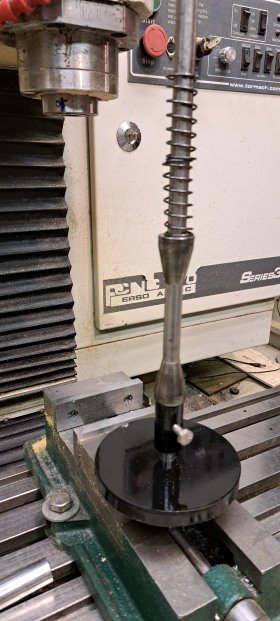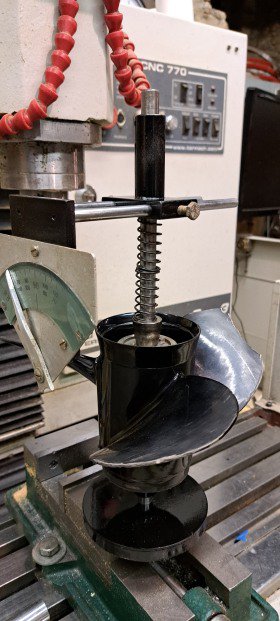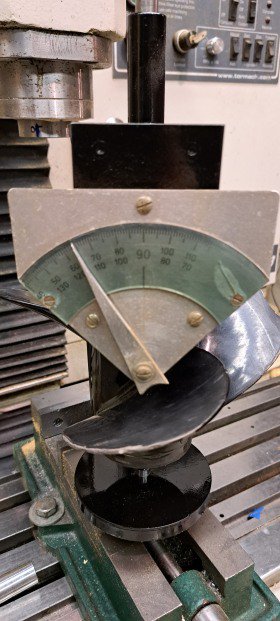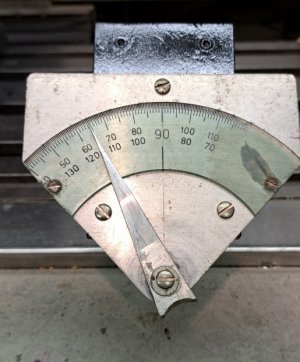- Joined
- Feb 1, 2015
- Messages
- 9,937
I recently had the need to replace the prop on my 50 hp outboard. A friend suggested that I verify that the prop was the correct pitch while I would still be able to return it. Normally, I would make a performance run but using the prop might prevent me from returning it. Then I remembered that some 35 years ago, I had made a prop pitch gage. It took a little digging to locate it and I was able to verify that the prop pitch was correct.
Measuring the pitch of a prop is fairly straightforward. The pitch is basically, the same parameter as a thread pitch. It is defined as the theoretical distance the prop will move the boat forward with each revolution. Measurement consists of determining the angle of the blade at any given distance from the rotational axis. The pitch is equal to the tangent of that angle/2πr.
To make the gage, I mounted a 1/2" diameter x 14" length of ground O1 to an 1/8" x 4" dia. steel plate on top of a large speaker magnet. An adjustable spacer sits above the base to provide clearance for the prop. Next are two opposing 25º cones which capture the prop and keep it concentric with the shaft. This is followed by a compression spring which supports the gage when not actually measuring the pitch angle.
The gage itself is made from a piece of 3/4" HR steel, bored to fit the shaft and riveted to a piece of 1-1/2" x 2-1/2" x 3/8" HR flat stock. The flat stock is cross drilled for two 1/4" shafts, spaced 1-1/2" apart and two 1/4-20 tapped holes for locking screws intersect those holes. The two 1/4" shafts are riveted into a 2-1/2" x 4" x 3/16" HR plate which provideds the mounting for the protractor.assembly. The protractor assembly consists of a piece of .063" aluminum with a section of a protractor scale mounted to it. A needle was fashioned from a piece of 1/8" aluminum. and mounted at the center of the protractor arc. The end of the needle opposite the pointer is fashioned into two contact points 1/2" from the pivot point and 1/2" apart. The points were worked so that when they were in contact with a surface perpendicular to the shaft, the pointer was reading 90º.
To adjust the radius, the gage was inverted on the shaft and the rod extension was adjusted so that the contact points were 3.75" from the shaft, giving a radius of 4". To measure the pitch of a prop, the prop is mounted on the stand between the two opposed cones.and the springs placed atop the upper cone. The gage is slipped onto the shaft and pushed down so the needle contacts the prop at the desired position, making sure that both points are in contact with the surface. The gage is allowed to move upward and the angle of the needle is read. As constructed, the pitch angle is actually 90º minus the read angle.
Checking my damaged prop, the angle was 25º for a tangent of .466. The 4" radius has a circumference of 25.1" which yields a pitch of 11.7". Checking the new prop, the pitch was also 11.7" so I should be good to go. The next test will be a performance test later this week.



The stand less prop and gage The stand with prop and gage The gage poised to measure the prop pitch

A closeup of the gage. In an attempt to glue a crack it the scale, I inadvertently obliterated part of the scale. That side of tyhe scal is for measuring L.H. props which are rare but it is still capable of measuring a 15" or less pitch.
Measuring the pitch of a prop is fairly straightforward. The pitch is basically, the same parameter as a thread pitch. It is defined as the theoretical distance the prop will move the boat forward with each revolution. Measurement consists of determining the angle of the blade at any given distance from the rotational axis. The pitch is equal to the tangent of that angle/2πr.
To make the gage, I mounted a 1/2" diameter x 14" length of ground O1 to an 1/8" x 4" dia. steel plate on top of a large speaker magnet. An adjustable spacer sits above the base to provide clearance for the prop. Next are two opposing 25º cones which capture the prop and keep it concentric with the shaft. This is followed by a compression spring which supports the gage when not actually measuring the pitch angle.
The gage itself is made from a piece of 3/4" HR steel, bored to fit the shaft and riveted to a piece of 1-1/2" x 2-1/2" x 3/8" HR flat stock. The flat stock is cross drilled for two 1/4" shafts, spaced 1-1/2" apart and two 1/4-20 tapped holes for locking screws intersect those holes. The two 1/4" shafts are riveted into a 2-1/2" x 4" x 3/16" HR plate which provideds the mounting for the protractor.assembly. The protractor assembly consists of a piece of .063" aluminum with a section of a protractor scale mounted to it. A needle was fashioned from a piece of 1/8" aluminum. and mounted at the center of the protractor arc. The end of the needle opposite the pointer is fashioned into two contact points 1/2" from the pivot point and 1/2" apart. The points were worked so that when they were in contact with a surface perpendicular to the shaft, the pointer was reading 90º.
To adjust the radius, the gage was inverted on the shaft and the rod extension was adjusted so that the contact points were 3.75" from the shaft, giving a radius of 4". To measure the pitch of a prop, the prop is mounted on the stand between the two opposed cones.and the springs placed atop the upper cone. The gage is slipped onto the shaft and pushed down so the needle contacts the prop at the desired position, making sure that both points are in contact with the surface. The gage is allowed to move upward and the angle of the needle is read. As constructed, the pitch angle is actually 90º minus the read angle.
Checking my damaged prop, the angle was 25º for a tangent of .466. The 4" radius has a circumference of 25.1" which yields a pitch of 11.7". Checking the new prop, the pitch was also 11.7" so I should be good to go. The next test will be a performance test later this week.




The stand less prop and gage The stand with prop and gage The gage poised to measure the prop pitch

A closeup of the gage. In an attempt to glue a crack it the scale, I inadvertently obliterated part of the scale. That side of tyhe scal is for measuring L.H. props which are rare but it is still capable of measuring a 15" or less pitch.

